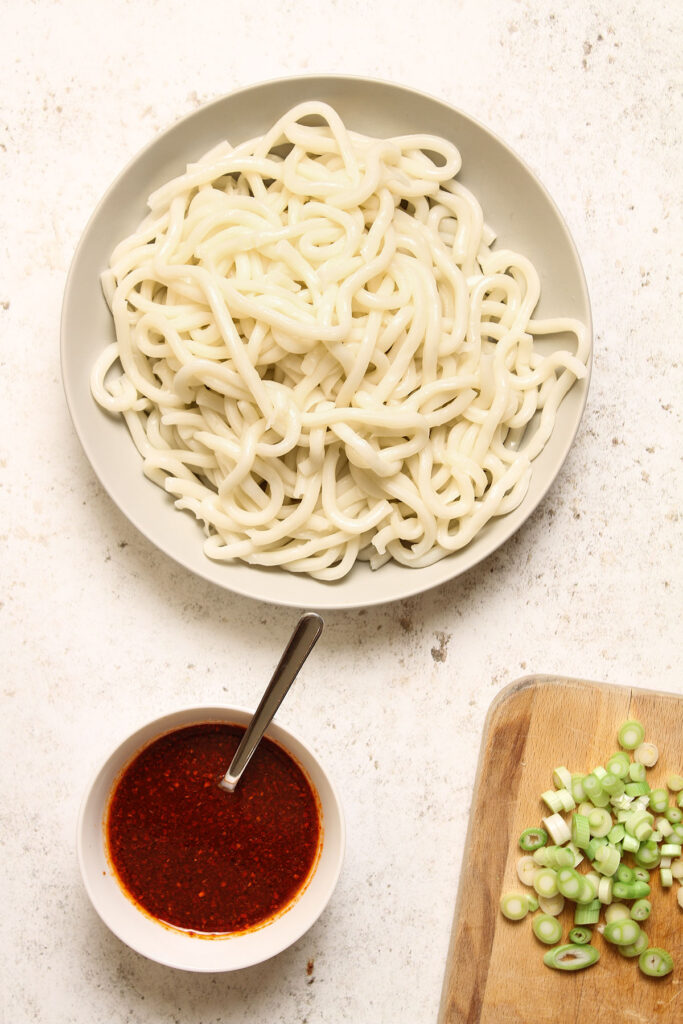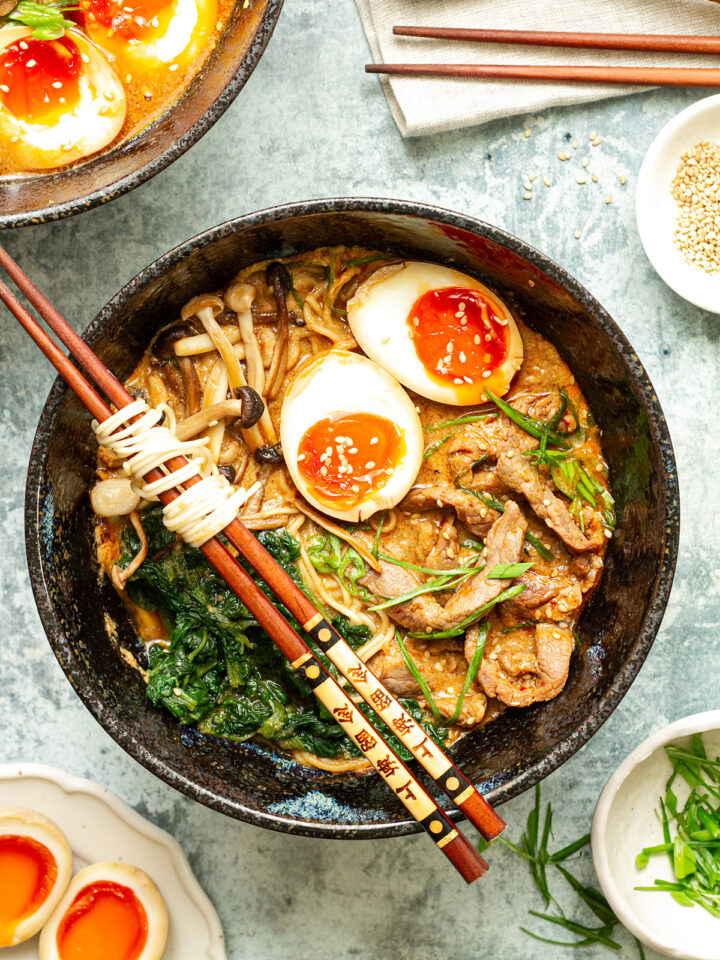Who doesn't love a simple, nutritious, one-pan noodle recipe that packs a punch? That's spicy Korean Noodles (Gochujang Noodles). With soft udon noodles, ground pork, veggies and kimchi in a delicious spicy gochujang sauce, they're nutritious, full of flavor and so easy to put together. With just 30 minutes of cooking and prep time you can whip up this delicious recipe any night of the week.

If you're after more one-pan noodle dishes, you should take a look at my Chicken Chow Mein, Special Chow Mein, Singapore Chow Mein (Singapore Noodles) and Teriyaki Salmon Noodle Stir Fry.
The post contains additional information and helpful tips to ensure the recipe turns out great the first time. Please use the link above to jump to the recipe card at the end if you are in a hurry!
✅ 5 reasons why you'll love this recipe:
- Saucy noodles with the best gochujang sauce
- So tasty and packed with your favorite Korean flavors
- Quick and easy
- Customizable
- Creates yummy leftovers
🛒 Ingredients

- Noodles: I often make this recipe with udon noodles but you can also use egg noodles, instant ramen noodles or rice noodles.
- Ground pork. Its flavor goes well with the fermented taste of kimchi and gochujang.
- Veggies: The recipe uses cabbage and carrot but there are lots of other options. This is a great fridge-clear-out dish.
- Kimchi adds a sourness that contrasts with the other savory flavors from the pork and Gochujang paste. You could swap it for sauerkraut.
- Eggs are optional but highly recommended, I love to serve these noodles with a fried egg on top. The soft runny yolk combined with the savory flavor of the gochujang noodle sauce is the best combination.
Spicy sauce ingredients:
Like most fried noodle dishes, a good sauce is key. My sauce is made from soy sauce, kimchi juice, rice vinegar, sesame oil, and red pepper flakes. Now let's have a look at some of the key ingredients and where you can find them.
- Gochujang paste: the key ingredient that adds warmth and delicious savory flavor
- Soy sauce: use regular or light soy sauce. Avoid dark as it will make the sauce too rich.
- Rice vinegar: substitute with apple cider vinegar.
- Sesame oil: can be swapped for peanut oil or walnut oil
- Red pepper flakes (Gochugaru): Korean red pepper flakes add additional heat to the sauce. It's unlikely you'll find them in your local store so you'll need to visit an Asian grocery store or buy them online. You can use crushed red pepper, cayenne pepper or additional gochujang instead. You can also omit the red pepper flakes if you are sensitive to spice.
Gochujang paste
Gochujang paste (Korean chili paste) is a key ingredient in the noodle sauce that adds heat and a delicious savory flavor. It's also a key ingredient in the sauce used in my Kimchi Fried rice recipe.
Gochujang paste has become more widely known in recent years so you might be lucky enough to find it in your local store. If not most Asian markets will stock it and you can also buy it online.
Variations:
- Cold noodles (bibim guksu): Use chilled udon, vermicelli or glass noodles for an ideal summer dish.
- Switch up the veggies: Try green or red peppers, mushrooms, beans, broccoli, bok choy, or bean sprouts.
- Use zucchini noodles for a lighter option.
- Super spicy: Add gochujaru (Korean red pepper flakes), chilli powder or hot sauce for an extra kick.
- Switch up the meat: You can use ground beef, ground chicken or pieces of chicken pork or beef.
- Vegetarian/vegan: With fried tofu pieces or no meat and extra veggies.
🧑🍳 Recipe steps
Step 1: Cook the noodles according to package instructions in a large pot of boiling water, and run them under cold water. Then mix the sauce ingredients in a small bowl.

Step 2: Place a wok or large skillet on a high heat and add oil. Add the cabbage, onion and whites of the spring onions/scallions and toss for a few minutes until tender. Then add the kimchi and garlic and fry for 1-2 minutes.

Step 3: Add the ground pork to the pan and toss until browned.

Step 4: Add the cooked noodles, and toss on a medium to high heat until they become hot. Then pour on the sauce, mix and serve immediately topped with the green parts of the spring onion, sesame seeds and optional fried eggs.

Serving suggestions
With a good balance of protein and veggies, Korean Spicy noodles are certainly a meal in their own right. When it comes to sides Korean spinach, Spicy Cucumber Salad or fried zucchini will pair nicely.
👍 Top tips
- Run noodles under cold water - this prevents them from overcooking and sticking together
- Prep the ingredients before you start cooking - things will move quickly once you start cooking, there's no time to chop veggies as you go.
- Serve with a fried egg - a soft runny yolk pairs up wonderfully with the flavors of kimchi and gochujang.

📦 Storage
Leftovers can be stored in the fridge for up to 3 days. Simply put them into a bowl covered with plastic wrap or a sealed container, store in the fridge when cool and reheat thoroughly in the stove or in the microwave.
The noodles can be frozen for up to three months. Simply place them in a plastic container or freezer bag and put them into the freezer when cool. Remove them from the freezer 24 hours before you plan to eat them and thaw in the fridge.
FAQs
Gochujang is a spicy Korean red pepper paste and is a key condiment in Korean cooking that is often found in stews, marinades, soup and stir-fries. Made with red chilli peppers, sticky rice, fermented soybeans and salt it adds a delicious deep umami flavor to dishes as well as heat.
There are lots of options. Gochujang is very versatile and is used in a variety of Korean dishes including Kimchi fried rice, Korean Chicken stew and Korean Fried Chicken. It is often used in marinades, sauces, stews and soups but can also be used on more Western-style dishes like pasta and grilled cheese.
When used in my noodle sauce, Gochujang paste isn't overly spicy. I'd say it's mild to medium. The spice level of Gochujang paste can vary depending on the brand. Sometimes the packaging will give an indication of spiciness. Look to avoid any very hot varieties unless you really love spicy food. If you are sensitive to spice you can reduce the amount of Gochujang and red pepper flakes in the sauce and add more to taste.
Gochujang keeps in the fridge for up to two years so there's no need to worry about it going to waste.
😋 More spicy noodle recipes
Did you try this recipe? It would be really great if you could leave a comment and a star rating ⭐️. I would love to receive your feedback and know that other readers find it helpful too.
Don't forget to tag #knifeandsoulrecipes on Instagram or @knifeandsoul on Pinterest!
📖 Recipe

Spicy Korean Noodles (Gochujang noodles)
Equipment
- 1 wok
Ingredients
Sauce
- 1 tbsp gochujang paste (Note 1)
- 3 tbsp soy sauce (Note 2)
- 1 tbsp sesame oil (Note 3)
- 2 tbsp kimchi juice (Note 4)
- 1 tbsp rice vinegar (Note 5)
- 60 ml (¼ cup) water
- 2 tsp Korean red pepper flakes (Gochugaru) (Note 6)
Noodles
- 2 tbsp oil (Note 7)
- 4 scallions (green onions / spring onions) finely chopped with green and white parts separated
- 250 g (9oz) cabbage finely shredded
- 2 medium sized carrots chopped into matchsticks
- 120 g (¾ cup) kimchi (Note 4)
- 3 cloves garlic crushed
- 250 g (9 oz) ground pork optional (Note 8)
- 4 portions cooked udon noodles (Note 9)
- 4 eggs optional
- Sesame seeds to serve, optional
Instructions
- Mix the sauce ingredients in a small jug or bowl
- Cook the noodles according to packet instructions and run cold water over them to prevent them from cooking further.
- Place a wok or large frying pan on a medium heat and add oil
- Add the whites of the spring onions/scallions, cabbage and carrot and fry for a few minutes until tender.
- Add the kimchi and garlic and fry for 1 minute.
- Add the pork mince and toss in the pan for a few minutes until brown.
- Place a separate frying pan on a medium heat, add a little oil and fry the eggs if using.
- Meanwhile, add the noodles to the pan and toss until they become hot.
- Pour in the sauce, toss together with the noodles and serve topped with the green parts of the spring onions / scallions and sesame seeds.
Notes
- Gochujang paste is a key ingredient in the noodle sauce that adds heat and delicious savory flavor. If you can't find it in your local store you can buy it from an Asian grocery store or online.
- Soy sauce: use regular or light soy sauce. Avoid dark because it will make the noodle sauce too rich.
- Sesame oil: substitute with peanut or walnut oil.
- Kimchi: Korean fermented pickled vegetables (usually cabbage). If you can't find it in your local store you can buy it from an Asian grocery store or online. It comes packed in kimchi juice, one of the key ingredients in the noodle sauce.
- Rice vinegar: can be substituted with apple cider vinegar.
- Red pepper flakes (Gochugaru): Korean red pepper flakes that add additional heat to the sauce. It's unlikely you'll find them in your local store so you'll need to visit an Asian grocery store or buy them online. You can use crushed red pepper, cayenne pepper or additional gochujang instead. You can also omit the red pepper flakes if you are sensitive to spice.
- Oil: use a neutral oil with a high burn point like groundnut, vegetable or sunflower oil.
- Ground pork: can be swapped for ground beef or chicken. You can also use tofu or omit to make the dish vegetarian.
- Udon noodles: you can use egg noodles instead cooked according to packet instructions.











Leave a Reply